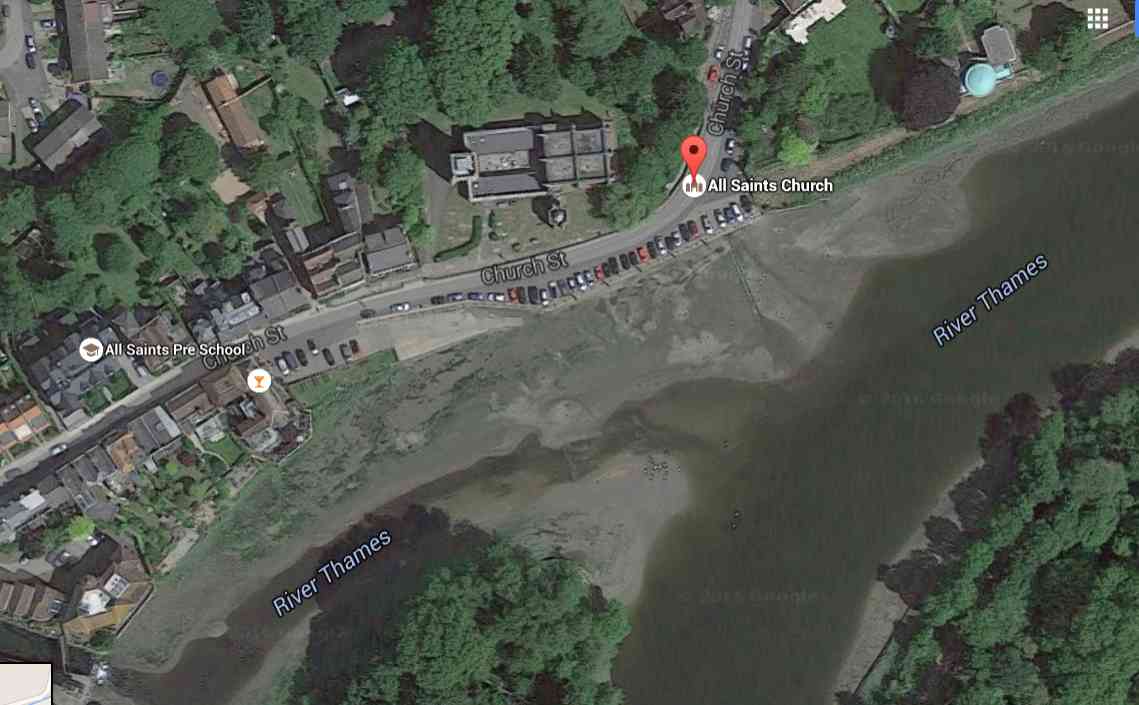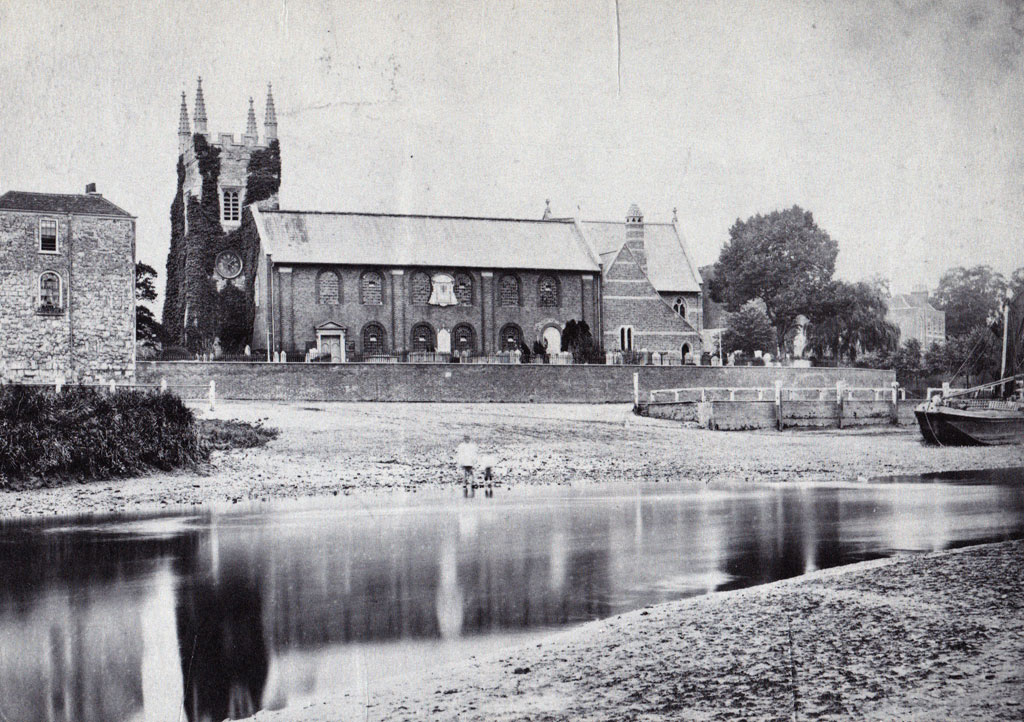平凡地英国週末一行An average weekend day in England 14 May 2016
An impromptu snapshot using a mobile phone of a casual stroll in Church Street, Old Isleworth. This captureed the mood of an average but popular visit to a river bank along The Thames river on a fine day (Saturday, 14 May 2016). I hope this gallery captures an example of how one passes time here in England without the internet. A moment to reflect and to enjoy what's around us that's green, tranquil, slow and pleasant. 丰富英国风格的随便河边散步西南伦敦·

With reference to the above map, my stroll as shown with photo gallery was from red Google marker along Church Street towards All Saints Pre-School. Note that the above map shows The Thames in low tide, in high tide, the water comes close to where the cars are. 由地图红点向西步行
Some notes on local history using the photographs below:-
- A brief history of Old Isleworth (now in South West London) was first settled about 4,000 years ago.
- Old Village life in London typically had evolved around a church (Church of England), the All Saints' Church at Isleworth is one such typical example. No one knows when the first Christians first gathered but the Church of Isleworth was first mentioned in year 695 in The Bishop of London's Charter (and in Gislheresuuyrth – from an Anglo Saxon Cha
 Isleworth Stairs, drawing circa 1900, now no longer exist, the tower with weather vane is the Old Blue School.rter, 'Gislheresuuyrth', means in Old English Enclosure belonging to [a man called] Gīslhere). The present tall bell tower was erected in 1398. Today there are about 120 people in the Sunday morning traditional congregation at 9:30 and about 40 in the late Sunday morning modern congregation with "pop" music. The gallery below shows the church in May 2016 but further down this web page shows the church before 1943.
Isleworth Stairs, drawing circa 1900, now no longer exist, the tower with weather vane is the Old Blue School.rter, 'Gislheresuuyrth', means in Old English Enclosure belonging to [a man called] Gīslhere). The present tall bell tower was erected in 1398. Today there are about 120 people in the Sunday morning traditional congregation at 9:30 and about 40 in the late Sunday morning modern congregation with "pop" music. The gallery below shows the church in May 2016 but further down this web page shows the church before 1943. - There are two English pubs near by, one of which is the London Apprentice Pubic House , marked on above map with a wine glass symbol, its present building dates to the early 18th century, was recorded as licensed to sell alcohol from year 1731. However the current pub owner claims on his web site,"The pub is said to have been patronised by such eminent personalities as Henry VIII, Charles I, Charles II (with Nell Gwynne), Lady Jane Grey and Oliver Cromwell...." This claim was not substantiated with evidence, my reasoning is based on when these famous people had lived: Henry VIII died 1547, Charles I died1649, Charles II died 1685 (with Nell Gwynne died 1687), Lady Jane Grey died 1554 and Oliver Cromwell died 1658, this public house was built in Georgian architectural style (between 1714 and 1830) and according to the English Heritage had recorded this building as Early C18 no ealier than 1700. However some parts of this building is from the 14th Century. It was most probably true that famous people did drink a lot of beer on location then ( In 1541 Queen Katherine Howard was imprisoned at Syon for three months. The Royal Barge that took her on her fateful journey, to have her head cut off, to the Tower of London left from "Isleworth Stairs" which no longer exists but was very near to The London Apprentice (above drawing was the "Isleworth Stairs" in 1900 with the tower of "The Blue School" in the background, established in 1630, is one of the oldest Church of England schools in England which is still teaching today).
- The Sir Orlando Gee's Memorial, last photo below, is a half-length effigy in white marble. He is represented wearing a flowing peruke. The epitaph was written in late "Early Modern English" ~1700, read here if you find text hard to read.
艾尔沃斯河边 Isleworth river bank, Church Street,
The above gallery follows a typical itinerary by a river:-
- Go to river, optionally feed ducks and geese, view the river scenes, walk along the embankment,
- Visit and buy food and drink at market, if there is one, held once a month at a weekend, usually Saturday (not Sunday for church goers),
- Alternatively or as well as, take English tea and cake at a communual building (church, scout group, community centre), volunteers baking cakes for sale, serving English tea are an important feature of English life in fund raising; visit and take note of the history of the (old) buildings nearby, (research on history afterwards),
- Optionally visit a local English pub to have a pint and to eat lunch.
This was how the All Saints Church was before the fateful night Friday, 28th May 1943 in which two boys, aged 12 and 13 set fire when they had broke in and had found no money inside. 以下照片是1943年之前,是这年(第二次生界大战)二个十二丶十三岁男孩破入教堂偷钱,找不到钱纵火。
 All Saints' Church before the fire in 1943
All Saints' Church before the fire in 1943
They also burnt another church on the following day, Saturday 29th March 1943, the Broadway Baptist in Hounslow. Fortunately that fire was extinguished before any real damage could be done. That same afternoon the Mission Hall in Wellington Road North also caught fire. Again the fire was quickly extinguished. The police were immediately suspicious and church officials were quietly advised to check and secure their premises. Three days later, on the afternoon of Tuesday 1st of June 1943, the same two boys set fire to the Parish Church of Hounslow (Holy Trinity) which was completely destroyed by fire. The two boys were caught and put into care. However their names were known by a few people who kept their names secret ever since (who would have been 85, 86 years of age in 2016 if they still live in the same area).